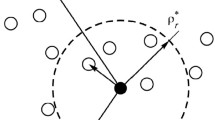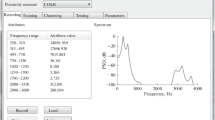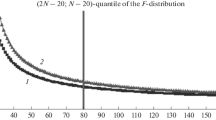Abstract
The problem of distinguishing random signals with similar spectral and correlational characteristics is considered. To solve this problem, a criterion for a minimum of the mean divergence of the hypotheses taken with respect to the true distribution in the Kullback–Liebler information metric is proposed. Using this criterion, an optimal algorithm is synthesized, which allows achieving a guaranteed efficiency gain in discriminating random signals of similar structure. An example of its implementation in the problem of automatic speech recognition at the basic, phonetic level of signal processing is considered. Estimates of its effectiveness are obtained. Theoretical estimates of the effectiveness are confirmed by the results of the experiment. The author’s special-purpose information system was used for this. On the basis of the obtained results, recommendations are given for the practical application of the proposed criterion in problems of statistical signal processing, where a problem of verifying close statistical hypotheses arises.
Similar content being viewed by others
References
A. A. Kolchev, A. E. Nedopekin, “Application of model of mixture of probabilistic distributions for definition of the signals of radiophysical probing,” Radioelectron. Commun. Syst. 59, No. 8, 362 (2016). DOI: 10.3103/S0735272716080057.
V. V. Skachkov, V. V. Chepkyi, H. D. Bratchenko, A. N. Efymchykov, “Entropy approach to the investigation of information capabilities of adaptive radio engineering system in conditions of intrasystem uncertainty,” Radioelectron. Commun. Syst. 58, No. 6, 241 (2015). DOI: 10.3103/S0735272715060011.
A. M. Prodeus, V. S. Didkovskyi, “Objective estimation of the quality of radical noise suppression algorithms,” Radioelectron. Commun. Syst. 59, No. 11, 502 (2016). DOI: 10.3103/S0735272716110042.
V. V. Savchenko, “Enhancement of the noise immunity of a voice-activated robotics control system based on phonetic word decoding method,” J. Commun. Technol. Electron. 61, No. 12, 1374 (2016). DOI: 10.1134/S1064226916120226.
V. V. Savchenko, “Estimation of the phonetic speech quality using the information theoretic approach,” J. Commun. Technol. Electron. 63, No. 1, 53 (2018). DOI: 10.1134/S1064226918010126.
A. V. Akimov, A. A. Sirota, “Synthesis and analysis of algorithms for digital signal recognition in conditions of deforming distortions and additive noise,” Radioelectron. Commun. Syst. 60, No. 10, 458 (2017). DOI: 10.3103/S0735272717100041.
O. S. Neuimin, S. Ya. Zhuk, “Adaptive sequential detection of target trajectory using decision statistics of pips at the unknown signal-to-noise ratio,” Radioelectron. Commun. Syst. 59, No. 8, 352 (2016). DOI: 10.3103/S0735272716080045.
V. V. Savchenko, “Solving the problem of multiple comparisons for automatic signal recognition at the output of the voice communication path,” Elektrosvyaz’, No. 12, 22 (2017).
A. V. Savchenko, “Clustering and maximum likelihood search for efficient statistical classification with medium-sized databases,” Optimization Lett. 11, No. 2, 329 (2017). DOI: 10.1007/s11590-015-0948-6.
E. Leman, Testing of Statistical Hypotheses [in Russian] (Nauka, Moscow, 1979).
A. A. Borovkov, Mathematical Statistics [in Russian] (Lan’, St. Petersburg, 2010).
B. R. Levin, Theoretical Fundamentals of Statistical Radioenginering, 3rd ed. (Radio i Svyaz’, Moscow, 1989).
E. L. Lehmann, J. P. Romano, Testing Statistical Hypotheses, 3rd ed. (Springer, New York, 2005). DOI: 10.1007/0-387-27605-X.
A. I. Rybin, Yu. Kh. Nizhebetskaya, “Analysis of images similarity and difference using normal orthogonal conversion,” Radioelectron. Commun. Syst. 53, No. 3, 167 (2010). DOI: 10.3103/S0735272710030076.
A. A. Popov, “Sampling theorem for signals of the space built on the generalized Boolean algebra with measure,” Radioelectron. Commun. Syst. 53, No. 1, 25 (2010). DOI: 10.3103/S073527271001005X.
B. Y. Lemeshko, S. B. Lemeshko, S. N. Postovalov, “The power of goodness of fit tests for close alternatives,” Meas. Tech. 50, No. 2, 132 (2007). DOI: 10.1007/s11018-007-0036-0.
V. V. Savchenko, A. V. Savchenko, “Information-theoretic analysis of efficiency of the phonetic encoding-decoding method in automatic speech recognition,” J. Commun. Technol. Electron. 61, No. 4, 430 (2016). DOI: 10.1134/S1064226916040112.
S. Ya. Zhuk, V. I. Kovalev, “Algorithm for combined filtering of the speech signal and estimate of the synchronization error in a two-channel measuring system,” Radioelectron. Commun. Syst. 43, No. 6, 36 (2000). URI: http://radio.kpi.ua/article/view/S0021347000060078.
A. V. Savchenko, “Sequential three-way decisions in efficient classification of piecewise stationary speech signals,” Int. Joint Conf. Rough Sets 10314, 264 (2017). DOI: 10.1007/978-3-319-60840-2_19.
S. Kullback, Information Theory and Statistics (Dover Publications, New York, 1997).
V. V. Savchenko, “Principle of minimax entropy for statistical classification problems,” Radioelectron. Commun. Syst. 33, No. 12, 35 (1990).
D. Zhou, J. C. Platt, S. Basu, Yi. Mao, “Learning from the Wisdom of crowds by minimax entropy,” Proc. of 25th Int. Conf. on Neural Information Processing Systems, 3–6 Dec. 2012, Lake Tahoe, Nevada, USA. 2012, Vol. 2, pp. 2195–2203.
S. L. Marple, Digital Spectral Analysis (Prentice Hall, Englewood Cliffs. NJ, 1987).
A. A. Bylinkin, S. L. Konov, “Methods of random signals recognition according to the form of spectrum,” Information Security Questions, No. 2, 30 (2017). URI: https://elibrary.ru/item.asp?id=29207442.
A. A. Konev, R. V. Meshcheryakov, I. A. Khodashynskiy, “Recognition of vowel sounds using first and second harmonics,” Proc. of Sixth Interdisciplinary Seminar on Analysis of Spoken Russian Language (Saint Petersburg State University, 2012) [ed. by A. L. Ronzhyn], p. 35.
Author information
Authors and Affiliations
Corresponding author
Additional information
Original Russian Text © V.V. Savchenko, 2018, published in Izvestiya Vysshikh Uchebnykh Zavedenii, Radioelektronika, 2018, Vol. 61, No. 9, pp. 536–548.
About this article
Cite this article
Savchenko, V.V. Criterion for Minimum of Mean Information Deviation for Distinguishing Random Signals with Similar Characteristics. Radioelectron.Commun.Syst. 61, 419–430 (2018). https://doi.org/10.3103/S0735272718090042
Received:
Published:
Issue Date:
DOI: https://doi.org/10.3103/S0735272718090042




